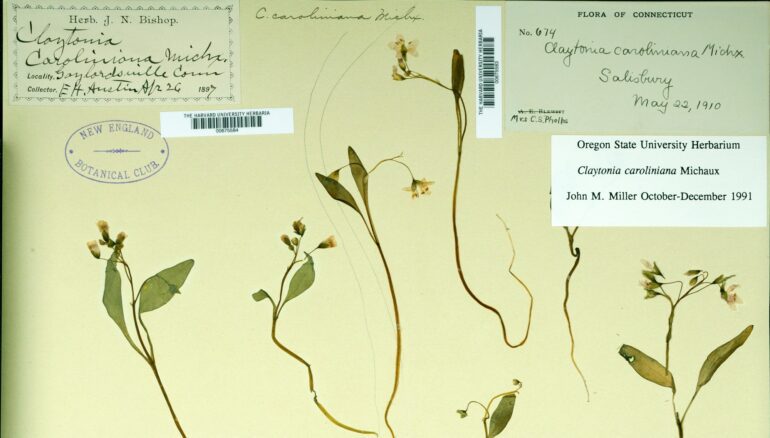TL;DR:
- Scientists employ AI to extract data from herbaria, unlocking insights into climate change’s effect on plant species.
- AI algorithms analyze leaf size within species and reveal that factors beyond climate influence leaf size.
- Digitization of herbarium collections enables widespread access to invaluable scientific resources.
- Machine learning algorithms accurately measure leaf size and offer efficient documentation of climate change effects.
- Unexpected findings prompt further exploration of gene flow’s role in hindering consistent leaf size-climate relationships.
- AI technology enables predictions about plant responses to future climate change.
Main AI News:
In a groundbreaking achievement, a collaborative effort between UNSW and the Botanic Gardens of Sydney has harnessed the power of artificial intelligence (AI) to extract valuable data from millions of preserved plant specimens held in herbaria worldwide. This pioneering research aims to better understand and combat the far-reaching effects of climate change on Earth’s flora.
Associate Professor Will Cornwell, the lead author of the study, describes herbarium collections as remarkable time capsules housing a wealth of plant specimens. With over 8,000 new additions annually to the National Herbarium of New South Wales alone, manual examination of these collections has become an insurmountable task. Recognizing this challenge, the team turned to advanced machine learning algorithms to analyze over 3,000 leaf samples, ultimately uncovering a surprising revelation about leaf size and its relationship to climate.
Contrary to conventional wisdom that suggests an increase in leaf size for a given species in warmer climates, the team’s findings, published in the esteemed American Journal of Botany, challenge this assumption. They discovered that factors beyond climate play a significant role in determining leaf size within a plant species. This groundbreaking research not only highlights the multifaceted influences on plant physiology but also demonstrates the remarkable potential of AI in transforming static specimen collections into powerful tools for documenting climate change impacts efficiently.
A Digital Metamorphosis: Herbarium Collections Embrace the Digital Era
Herbaria, scientific repositories of plant specimens, have been in existence since the 16th century, serving as invaluable resources for scientific research. Traditionally, these collections were confined to small boxes in specific locations, hindering widespread access for scientists worldwide. However, with the advent of the digital age, efforts have been made to digitize and make these collections accessible to foster scientific collaboration.
The Botanic Gardens of Sydney spearheaded an ambitious project, spanning two years, to capture high-resolution digital images of over one million plant specimens from the National Herbarium of New South Wales. Following the completion of this monumental undertaking, Dr. Jason Bragg from the Botanic Gardens reached out to Associate Professor Cornwell to explore the integration of machine learning into the analysis of these digital herbarium images.
Collaborating with Dr. Bragg and UNSW Honours student Brendan Wilde, Associate Professor Cornwell developed an automated algorithm empowered by computer vision—a type of AI known as a convolutional neural network. This cutting-edge technology enabled the algorithm to detect and measure leaf size from scanned herbarium samples, focusing on two plant genera: Syzygium and Ficus. Through this innovative approach, the team achieved rapid processing and comprehensive characterization of the specimens, revolutionizing the study of leaf size in relation to climate.
A Breakthrough: Challenging Established Patterns
In the botanical realm, it has long been observed that plants in wetter climates tend to exhibit larger leaves compared to those in drier regions. This consistent pattern across species worldwide prompted the team to investigate whether the same relationship would hold true within a single species, given the vast amount of data now available.
Applying their machine learning algorithm, the team analyzed the correlation between leaf size and climate both within and among species of Syzygium and Ficus plants. Surprisingly, their findings deviated from the anticipated norm. While the expected pattern emerged when comparing different species, it did not manifest within a single species on a global scale. This deviation suggests the operation of a distinct process called gene flow within species, weakening local-scale plant adaptation and impeding the development of a consistent leaf size-climate relationship.
Paving the Way for Predicting Climate Change Responses
The AI-driven approach employed in leaf detection and measurement, while not achieving pixel-perfect accuracy, delivered sufficiently accurate results for exploring connections between leaf traits and climate. Associate Professor Cornwell emphasizes the significant potential of these machine learning algorithms in documenting climate change effects effectively, owing to the rapid pace of global transformations and the vast amount of available data.
Moreover, AI algorithms possess the remarkable capability to identify trends that may elude human researchers initially. This opens up exciting possibilities for gaining novel insights into plant evolution, adaptation, and, critically, predicting how plants might respond to the future ramifications of climate change.
Conclusion:
The groundbreaking use of AI in unlocking the hidden information within herbarium collections offers profound implications for the market. This innovation enhances our understanding of the impact of climate change on plant species, providing crucial insights for conservation efforts, agricultural practices, and ecological management. The digitization of herbaria not only facilitates scientific collaboration but also creates opportunities for commercial applications, such as the development of advanced agricultural technologies and predictive modeling tools. As AI continues to revolutionize botanical research, businesses operating in the environmental and agricultural sectors can leverage this knowledge to make informed decisions, adapt to changing climatic conditions, and contribute to sustainable practices.

